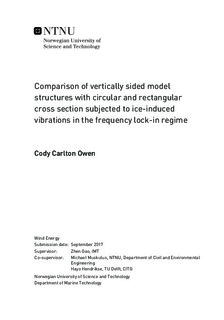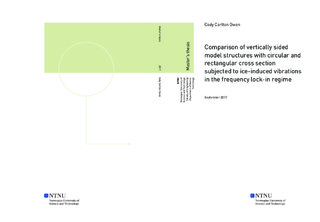| dc.description.abstract | Very recently, offshore wind energy has begun expanding into subarctic regions with seasonally ice-infested waters like the Baltic Sea. For offshore wind turbines with conventional support structures including monopiles and jackets that are typically flexible and vertically sided, the phenomenon known as ice-induced vibrations can develop. In response to the growing interest in offshore wind in the Baltic Sea and in further validating a state-of-the-art numerical model for ice-structure interaction, the Ice-induced Vibrations of Offshore Structures (IVOS) project has been coordinated with the Hamburg Ship Model Basin (HSVA) and many academic and industry partners including TU Delft and NTNU in order to enhance understanding of the topic via a comprehensive laboratory testing campaign.
In this thesis, specific data are selected from the extensive IVOS Phase 2 tests such that a comparative analysis is performed between two different model-scale structures, one with circular cross-section and another with rectangular cross-section, that were subjected to ice-induced vibrations in the frequency lock-in regime. Preceding the comparative analysis, the data from the IVOS Phase 2 tests are organized into a database and post-processing tools are developed to facilitate further research by supplying analysis-ready data sets. Included in the post-processing tools is an attempt to determine ice-induced global loads from uncalibrated tactile sensor data, which offers insight into the relationship between the relative pressure distributions along the ice-structure interface and the ice-induced global forces on the model structure.
The comparative analysis garnered qualitative information about the frequency lock-in regime and buckling failure of ice. It is observed that frequency lock-in vibrations usually persisted regardless of buckling events. For the frequency lock-in regime, the ice-induced global loads on the circular cross-section structure are generally lower than those for the rectangular cross-section structure. It is unclear whether the difference in global loads between the structures is caused by the difference in cross-sectional shape, other structural properties, ice properties, or combinations thereof. The analysis of the energy of the system is intriguing but does not offer lucid conclusions. However, the quasi-figure-eight pattern from the x-direction and derived y-direction structural displacements is an enlightening discovery that may explain inconsistencies in the energy of the system. Based on the general configuration of the test apparatus from the IVOS Phase 2 tests and the results from the comparative analysis, it can be concluded that ice-induced vibrations of the model-scale structures in the frequency lock-in regime should be regarded as a two-dimensional problem. | |

